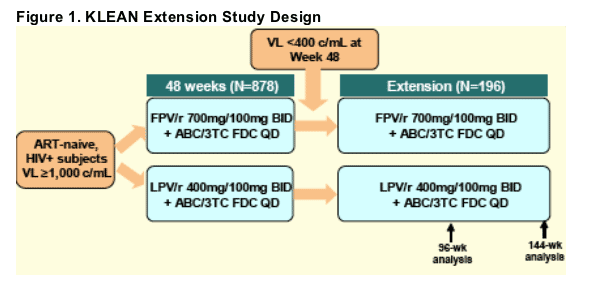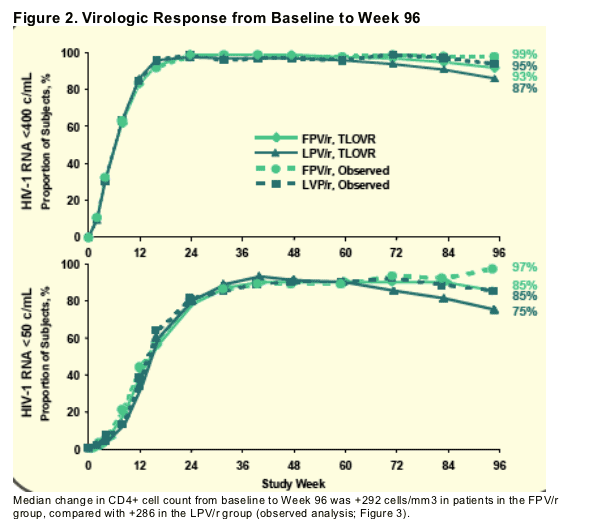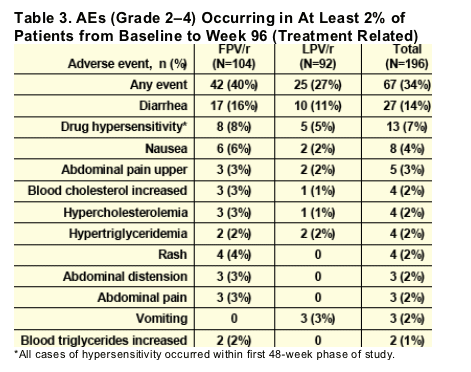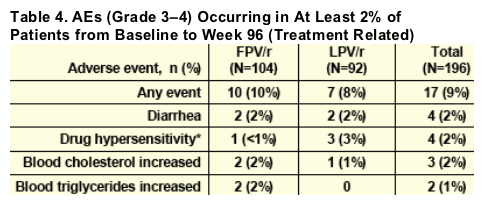 |
 |
 |
| |
Long-term Efficacy and Safety of Fosamprenavir + Ritonavir (FPV/r) Versus Lopinavir/Ritonavir (LPV/r) over 96 Weeks
|
| |
| |
Reported by Jules Levin, Monday afternoon Sept 17
ICAAC Sept 17-20, 2007
F Pulido1, JG Baril2, S Staszewski3, MA Khuong-Josses4, L Yau5, C Vavro5, ML Lim6
1Hosp. Univ 12 de Octubre, Madrid, Spain; 2Clinique du Quartier Latin, Montreal, Canada; 3JW Goethe Univ, Frankfurt, Germany; 4H˘pital Delafontaine, Saint-Denis, France; 5GlaxoSmithKline, Research Triangle Park, NC, USA; 6GlaxoSmithKline, Brentford, UK
AUTHOR CONCLUSIONS
--Follow-up of patients in the KLEAN study confirms sustained efficacy and tolerability of FPV/r and LPV/r up to 96 weeks.
--Long-term safety of FPV/r with ABC/3TC was also observed.
--No treatment-emergent major PI-associated mutations or reduced PI-associated phenotypic susceptibility was detected up to 96 weeks.
--Follow-up will continue to 144 weeks.
INTRODUCTION
The KLEAN study is an open-label, randomized, non-inferiority study comparing fosamprenavir/ritonavir (FPV/r) 700/100 mg twice daily (BID) with lopinavir/ritonavir (LPV/r) 400/100 mg BID, each in combination with abacavir/lamivudine fixed-dose combination (ABC/3TC FDC) 600/300 mg once daily (QD), in antiretroviral (ART)-naive patients.
At 48 weeks, FPV/r BID was shown to have comparable efficacy to LPV/r BID, with 73% patients in the FPV/r group achieving HIV-1 RNA <400 copies/mL compared with 71% in the LPV/r group (ITT-E, time to loss of virologic response [TLOVR] analysis). Few subjects experienced protocol-defined virologic failure and no major protease inhibitor (PI)-associated mutations [1] or reduced phenotypic susceptibility emerged toward either PI [2]. Treatment discontinuations due to an adverse event (AE) were few and occurred with similar frequency in the two treatment groups.
The efficacy and safety of these regimens beyond 48 weeks has not been previously compared. Here we present a planned 96-week analysis of the KLEAN study extension conducted in a subgroup of European and Canadian subjects.
METHODS
Subjects in Europe or Canada with viral load (VL) <400 copies/mL at Week 48 were permitted to continue up to 144 weeks (Figure 1). This is a planned 96-week analysis.
Protocol-defined virologic failure was any patient with confirmed HIV-1 RNA measurement ≥400 copies/mL.
Due to design limitations of extension, including reduced sample size and selection bias, statistical comparisons were not planned.

RESULTS
Study population
Of 878 treated subjects in the KLEAN study, 483 (55%) were from the US and did not participate, leaving approximately 284 remaining subjects from the EU and Canada with HIV-1 RNA <400 copies/mL at Week 48 who were potentially eligible for inclusion. Of these, 196 (22% of original study population) participated in the extension phase (ITT-E population).
Potential reasons for non-participation included subject off study prior to extension amendment, subject declined consent, did not meet inclusion/exclusion criteria, IRB/EC did not approve, subject participated in other study, or switch to other HAART regimen.
Baseline characteristics were similar between the two treatment groups (Table 1) and comparable to the original study population.

EFFICACY
At Week 96, 85% of patients in the FPV/r group and 75% in the LPV/r group achieved <50 copies/mL (TLOVR analysis; Figure 2).
93% of patients in the FPV/r group and 87% in the LPV/r group achieved <400 copies/mL (TLOVR analysis).

SAFETY
AEs were reported from baseline through Week 96 (Table 3). The safety population consisted of all randomized patients who received at least one dose of study drug and were analyzed by treatment actually received.
Subjects in the original study receiving LPV/r who experienced AEs in the first 48 weeks were less likely to participate in the study extension.
Although the reason for this is not clear, this selection bias could have impacted AE rates in the extension phase.
The most common AEs were diarrhea, drug hypersensitivity, nausea, and upper abdominal pain (Table 3).

The proportion of patients experiencing at least one severe (Grade 3-4) treatment-related AE was 10% in the FPV/r group and 8% in the LPV/r group (Table 4). Study withdrawals due to AEs were similar and low in both arms (2% in FPV/r vs 3% in LPV/r).

Median lipid values at Week 96 were similar for both arms (Figure 4) as were median changes from baseline to Week 96 in fasting total cholesterol (TC; +40.5 mg/dL vs +51.0 mg/dL), low-density lipoprotein (+11.0 mg/dL vs +16.0 mg/dL), high-density lipoprotein (HDL; +12.0 mg/dL vs +16.0 mg/dL), triglycerides (+55.0 mg/dL vs +72 mg/dL), and TC/HDL ratio (+0.06 vs -0.24) for FPV/r and LPV/r arms, respectively.

RESISTANCE
During the extension phase of the study, one patient in each treatment arm experienced confirmed virologic failure.
--One could not be genotyped (FPV/r arm).
--The other had a treatment-emergent, minor protease-associated mutation E35D/G (LPV/r arm) [1].
--There were no treatment-emergent genotypic mutations to FPV/r, LPV/r, or NRTIs, and no reduction in phenotypic susceptibility.
References
[1] VA Johnson, et al. Top HIV Med 2006; 14:125-130.
[2] J Eron, et al. Lancet 2006; 368:476-482.
|
| |
|
 |
 |
|
|